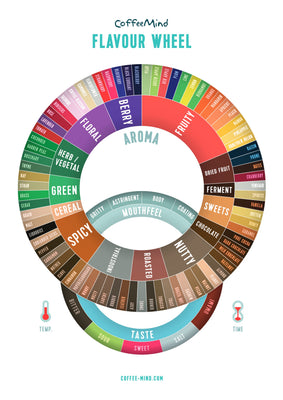
Flavour Perception
tai attitude5 min read
Imagine eating and drinking without flavour, like everything we eat would taste empty of the same, or the coffee we drink would taste still and all like water. If this is the reality, then life would be so dull.
Gratefully, we are gifted with senses. With our senses, we are able to, for example, perceive flavour in a variety of foods and drinks, be able to distinguish them, and more.
No flavour equals no story; it’s safe to say flavour makes food interesting to eat, and in our case here, it makes coffee intriguing to drink.
Flavour is something that enriches our daily lives. As we know, flavour is what we perceive in food and drinks, but let’s be able to explain why it is and how it works.
|
The flavour definition |
|
Three chemical senses |
|
Flavour is perception |
The flavour definition
Interestingly, flavour has a very standardised definition that is applicable to all the food industries, which also includes the coffee industry. Flavour is defined all the same because, from a human biological perspective, it works just the same, so let’s break it down.
Flavour is a multisensory experience perceived in the mouth; it is formed by the brain after a synthesis of data delivered by the three independent chemical senses of smell, taste, and mouthfeel.
 The three chemical senses deliver data to the brain in order for us to perceive flavour.
The three chemical senses deliver data to the brain in order for us to perceive flavour.
To elaborate, when we drink coffee, our three chemical senses work independently but simultaneously to collect respective data, then deliver it to the brain for it to synthesise all the collected data.
The brain will then conclude all synthesised data as a new piece of information; this new piece of information is why we perceive multisensory experience (flavour) in the mouth.
The entire process happens instantaneously as we drink. So it is like, as we drink, we perceive.
Metaphorically speaking, to put it in maths term, it would be,
Flavour = Aroma+Taste+Mouthfeel
Each of the senses needs to work properly in order for us to be able to perceive an overall flavour; when one is not working, we then lose our flavour.
For example, we lose flavour when we have flu, the is because our sense of smell is not working properly and cannot properly deliver aroma data to the brain for it to synthesise.
Taste + Mouthfeel = 0+Taste+Mouthfeel
Although having the flu causes us to lose the aroma component, we are still able to experience both taste and mouthfeel as each of the chemical senses operates independently.
However, this particular multisensory experience (flavour) is overall incomplete, as to receive a proper multisensory experience (flavour), all three chemical senses need to operate simultaneously.
This explains why food tastes weird in the mouth when it is our nose that has caught the flu.
Next, let us understand each of the chemical senses and how they operate in order to get the whole picture.
Three chemical senses
Smell (olfaction) is the sensory system through which odour, scent, and aroma are perceived.
Humans' sense of smell is the most impressive of the three, specifically, with over 800 aromatics that can be perceived in coffee.
We humans can perceive aroma in two pathways: via the nose and via the throat. Both pathways function at the same time.
Aroma, perceived via the nose through sniffing, is called orthonasal olfaction.
Aroma, perceived via the throat by breathing, as when there’s food or drink in the mouth, is called retronasal olfaction.
If we try not to inhale or exhale air when eating or drinking, we will then lose out on the aroma component of the food or drink, which will result in an incomplete multisensory experience (incomplete flavour).
Taste (gustation) is the sensory system through taste receptors located within the taste buds in our mouth, which is responsible for the perception of taste modalities.
Our human sense of taste can perceive five taste modalities: sweetness, sourness, saltiness, bitterness, and umami.
Coffee is a unique beverage because it has all five taste modalities.
Interestingly enough, there are not many foods or drinks out there that have all five tastes, but for coffee, it is possible to perceive sweetness, sourness, saltiness, bitterness, and umami all in the same cup.
Mouthfeel (trigeminal nerve) is the trigeminal sensation that is responsible for the perception of texture, temperature, and pain.
The trigeminal nerve fibres in the mouth are how we perceive the sense of touch for food and drink.
For coffee, the grittiness, astringency, body, or coating sensation are some examples of what we can perceive as mouthfeel.
In addition, the temperature of coffee is technically perceived as mouthfeel as well.
 The science behind flavour is the combination of smell, taste, and touch.
The science behind flavour is the combination of smell, taste, and touch.
Flavour is perception
Flavour itself is not a sense but rather a multi-sense.
By definition, the experience we receive via sense or multi-sense is called perception.
Flavour is a perception; it is our brain trying to interpret the real-life edible experience. The brain just happens to do so via the three chemical senses.
For example, when you have a coffee that has orange notes (perception), it is not because the coffee itself is orange juice, and don’t worry, the coffee is still coffee (reality).
In this case, the reason you perceived an orange note is that this particular coffee contributes a certain aroma, taste, and mouthfeel to the brain, and the brain concluded that it has similarities to the orange you had before.
This is why, when you drink this coffee, it “reminds” you of orange.
With over 1,000 chemical compounds that can be found in coffee, the possibilities for flavour perception in coffee are indeed limitless.
As perception, it also explains why everyone can get flavour differently despite drinking the same cup.
After all, flavour is merely a perception, whereas coffee is undeniably a reality.



